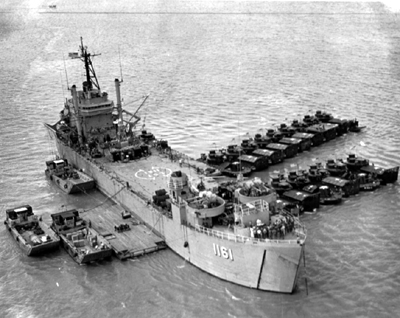LST WITH ARMORED TROOP CARRIERS AND MONITORS
Combined U.S. Army–U.S. Navy forces operating chiefly in the Mekong Delta during the Vietnam War. The mission of river assault groups was to patrol and control the primary communications routes in the Mekong Delta area and to prevent the resupply and movement of Viet Cong (VC) forces in the area.
Riverine warfare was certainly not a new concept for the U.S. military. Indeed, American military forces had conducted operations on inland waterways as early as the Revolutionary War and used river warfare frequently over the ensuing decades. Operations by the Union Army and the Union Navy on the great western rivers during the American Civil War had been particularly successful, and during the Philippine-American War U.S. forces successfully employed riverine warfare to subdue rebel forces.
In Vietnam, the French had used combined mobile river warfare forces in the Indochina War (1946–1954) in the Mekong Delta and the Red River Delta. As American involvement in the Republic of Vietnam (RVN, South Vietnam) deepened in the early 1960s, U.S. planners began to look for ways to interdict the flow of supplies to Communist VC forces in the Mekong Delta. In this, they looked to prior American and French experiences for ideas. Generally, all French river assault flotillas had a naval commando force or a light infantry company attached to it. The Americans thus used the same basic organization for their own river assault groups.
In establishing a riverine force in the Mekong Delta area, American planners had to address the problem of rugged terrain and inhospitable climate. Mobility would be difficult in an area with poor overland communications, shallow waters, and pervasive mud. Copying the French approach, the Americans decided to employ small landing craft as their primary assault vehicles. The workhorse of the American river flotilla was the river patrol boat (official designation Patrol Boat, River [PBR]). Driven by hydrojets, PBRs were capable of speeds of at least 30 knots and had a low profile to make them difficult targets. In addition, they could maneuver easily in shallow waters to wait in ambush or to offload troops.
The river assault group concept provided for widely varied types of tactical operations. The force would remain in a VC base area as long as operations could be profitably conducted, usually four to six weeks. Ground operations normally extended over four to five days, after which troops would be allowed two or three days of rest during which time they could both dry out and repair their equipment. Area commanders believed that river forces could mount four operations a month.
The infantry elements involved in river assault operations in the Mekong area came from battalions of the 47th and 60th Infantry regiments of the 2nd Brigade, 9th Infantry Division, based at Dong Tam near the Rung Sat swamps. The naval elements came from Task Force 116, Navy Assault Flotilla 1, the naval command responsible for preventing the flow of supplies and men to the Communist forces in the Mekong area.
Between late 1966 and August 1969, the river assault groups of the Mobile Riverine Warfare force engaged in reconnaissance, blocking, and pursuit operations throughout the Mekong Delta area, concentrating in the northern delta area near the Cambodian border and the Ca Mau Peninsula near the southernmost point of South Vietnam. With the implementation of Vietnamization in 1969, the river assault groups became less active. The U.S. Army– U.S. Navy Mobile Riverine Force was deactivated on August 25, 1969, and its infantry elements were withdrawn from Vietnam.
The river assault groups and the Mobile Riverine Warfare force achieved impressive results during their three years of operations. However, the force never had sufficient resources to close off all of the myriad routes that the Communists could use to bring supplies into South Vietnam from neighboring Cambodia.
References Cutler, Thomas J. Brown Water, Black Berets: Coastal and Riverine Warfare in Vietnam. Annapolis, MD: Naval Institute Press, 1988. Fulton, William B. Riverine Operations, 1966–1969. Washington, DC: Department of the Army, 1973. Wunderlin, Clarence E., Jr. “Paradox of Power: Infiltration, Coastal Surveillance, and the United States Navy in Vietnam, 1965–1968.” Journal of Military History 53 (July 1989): 275–290.
